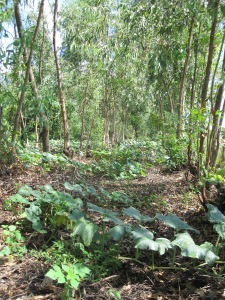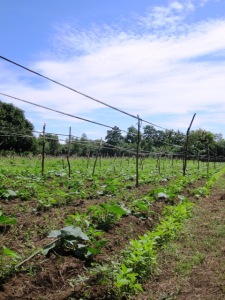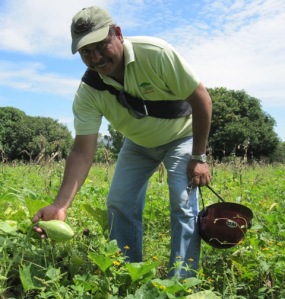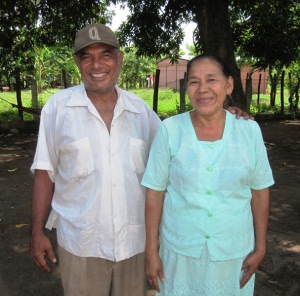
A client in Telica takes advantage of the soil fertility in a eucalyptus patch to plant pumpkins.
I’ve seen some creative garden designs among the CEPRODEL clients I’ve visited. One of the gardening methods that few larger farms adopt for scale reasons is companion planting, or mixing two or more species of plants in the same space to take advantage of different needs or services of each plant. A well-known example of companion planting in the states is the three-sisters garden, of corn beans and squash. I’ve seen many variations on that theme here.
Juana de la Rosa Sanchez Chevez and Miguel Angel Ruiz Lopez, clients in Telica, are innovating with new vegetable gardening methods. Miguel Angel’s farm is an example of how vegetable farming can be profitable with little land, although he admits that it is more labor intensive than the cattle farming that most farmers here focus on. His two acres in the town of Quetzalguaque is currently planted in pipian and ayote (two kinds of squash), cucumbers, sesame, sweet corn, and string beans. He has an intense rotation system.

Miguel Angel's row of sesame planted along side of his cucumber, which will climb a trellis. Climbing a trellis results in cucumbers that are green on all sides (instead of yellow where they rest on the ground), and also helps keep them free of bacterial and fungal soil diseases.
The season here is non-stop, because with a drip irrigation system he can grow year-round, and so he plants beans in rotation to allow the land to regenerate a bit. Unlike corn and squash, beans fix nitrogen in the soil and aren’t heavy feeders. We talked for over an hour about his garden, the different problems he’s encountered, and how his gardening methods have changed since he started. Some of his new experiments are,
– Using old drip tape for his cucumber trellises. The drip tape that has broken in smaller sections he can tie together. The test will be if it is strong enough to support the full-grown plants.
– Planting sesame as a repellent for comegenes, a grub that attacks the roots of crops. He heard that sesame exudes a bitter oil from its roots that soil grubs don’t like.
– Planting a mixture of ayote (kind of like pumpkin) and pipian (kind of like zucchini, but the plant grows more like a cucumber plant) between his rows of corn just as the corn is beginning to form fruit. The live corn plants protect

Raphael, one of the CEPRODEL rural credit supervisors in Telica, looking at the pipian.
the curcubit seedlings with a bit of shade, and then he lets the corn plants dry to harvest for tortilla corn and the squash plants take over. The pipian is harvested first, and the ayote second. He usually harvests the pumpkin green and small, to sell for putting in soup. But this year the price has dropped for ayote tierno, and so he is going to let them get big and riper to sell during the christmas season when people make candied pumpkin with dulce, an unrefined brown sugar.

Miguel Angel Ruiz Lopez y Juana de la Rosa Sanchez Chevez
Leave a comment